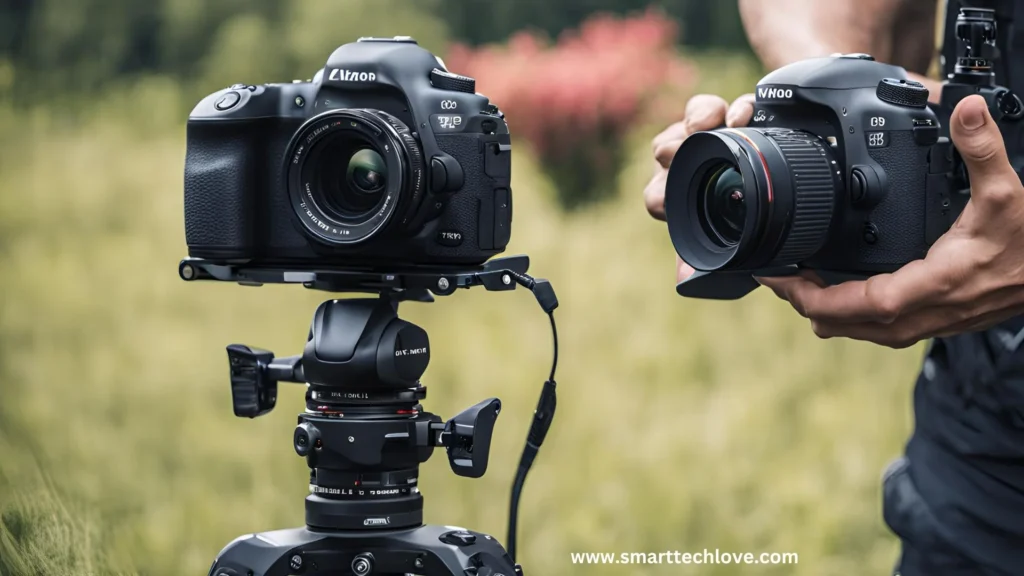In the fast-paced world of content creation, capturing engaging and high-quality videos is crucial. One effective method to enhance your productions is by using multiple cameras.
How to use two cameras for video can elevate your storytelling by providing varied angles and perspectives, making your content more dynamic.
This technique is particularly useful for interviews, tutorials, or events, as it allows you to capture different aspects of your subject and scene.
In this guide, I’ll explore the steps to effectively set up and utilize two cameras, from choosing the right location and angles to syncing footage in post-production. With these tips, you’ll be well on your way to creating visually captivating content.
Why Use Two Cameras?
Using multiple cameras allows for:
➤ Dynamic Angles: Capture different perspectives simultaneously.
➤ Seamless Transitions: Edit between angles for smoother storytelling.
➤ Redundancy: If one camera fails, you have backup footage.

How To Use Two Cameras For Video?
What You’ll Need
Before you start, gather the following equipment:
✔ Two Cameras: DSLRs, mirrorless cameras, or high-quality smartphones.
✔ Tripods or Stabilizers: To keep your shots steady.
✔ Audio Equipment: External microphones for better sound quality.
✔ Video Switcher (Optional): To switch between feeds in real-time.
✔ Editing Software: For post-production editing.
Using two cameras for video can create a dynamic and engaging final product. Here’s a more detailed guide based on your outline:
1. Choose Your Location
- Lighting: Look for natural light sources or set up artificial lighting to ensure your subject is well-lit.
- Background: Consider the backdrop to avoid distractions; a clean, uncluttered background works best.
2. Set Up the Tripods
- Stable Base: Ensure both tripods are stable and secure to avoid any camera movement during filming.
- Height Adjustment: Adjust the tripods to achieve the desired height for each camera, typically at eye level with the subject.
3. Angle the Cameras
- Main Camera: Position the first camera directly facing the subject for a standard shot.
- Secondary Camera: Angle the second camera at a different viewpoint (e.g., side angle, close-up) to capture varied shots.
4. Sync the Cameras
- Use Clapperboard or Audio Cue: Start both cameras simultaneously using a clap or audio cue to help sync in post-production.
- Timecode: If available, use timecode to keep footage aligned.
5. Monitor the Footage
- Check Composition: Look through each camera to ensure framing is correct before recording.
- Audio Check: If using external microphones, ensure they’re positioned well for clear audio.
6. Record
- Start Recording: Begin filming with both cameras, maintaining focus on the subject.
- Switch Angles: If needed, switch between cameras during the recording for variety.
7. Post-Production
- Editing Software: Import the footage into editing software that allows multi-camera editing.
- Sync and Edit: Sync the clips based on your audio cue or timecode, then edit together for a seamless flow.
8. Review and Finalize
- Watch the Edit: Review the final product to ensure smooth transitions and good pacing.
- Export: Once satisfied, export your video in the desired format.
What Is Dual Video Camera?
A dual video camera refers to a device equipped with two camera sensors that can record video simultaneously.
This setup allows for capturing different angles or perspectives at the same time, making it ideal for various applications like vlogging, live streaming, or filmmaking.
Some dual cameras also feature capabilities like picture-in-picture, where one camera feed is overlaid on another, providing a more dynamic viewing experience.
These cameras are popular for their versatility and ability to enhance storytelling by providing multiple viewpoints.
Can You Film With Two Different Cameras?
Yes, you can film with two different cameras, and this approach can enhance your production quality. Using multiple cameras allows for diverse angles and perspectives, capturing dynamic shots that a single camera might miss.
For instance, one camera can focus on close-ups while the other captures wider shots. This technique is commonly used in interviews, live events, and action scenes to create a more engaging viewing experience. Just ensure the cameras have similar settings for a cohesive final edit.
Do Youtubers Use Multiple Cameras?
Yes, many YouTubers use multiple cameras to enhance their videos. This technique allows them to capture different angles, add dynamic shots, and create a more engaging viewing experience.
For example, a vlogger might use one camera for wide shots and another for close-ups or reaction shots. This setup is especially common in tutorials, interviews, and gaming videos, where varied perspectives can help maintain viewer interest and improve production quality.
Using multiple cameras can also facilitate smoother edits.
What Apps Can I Use For Multiple Cameras?
For filming with multiple cameras, several apps can help streamline the process. ViuLive is a popular choice for live streaming and allows you to switch between multiple camera feeds seamlessly.
Zoom can also be utilized for multi-camera setups during live broadcasts or virtual events. For editing, Adobe Premiere Pro and Final Cut Pro offer robust features to sync and switch between different camera angles.
Conclusion
Incorporating two cameras into your video production is a game-changer that can significantly enhance your storytelling.
By capturing different angles and perspectives, you not only keep your audience engaged but also add depth to your content.
Effective use of lighting, careful framing, and proper syncing during editing are key to achieving a polished final product.
With a little planning and creativity, you can turn simple recordings into captivating videos that resonate with viewers.
Whether you’re working on interviews, tutorials, or creative projects, mastering the dual-camera setup will take your skills to the next level. Embrace this technique, and watch your video quality soar!
- Does AirTag Beep In Lost Mode? Find Out Here - November 24, 2024
- Can I Connect My AirPods To My TV? How To - November 23, 2024
- Can You Track AirTag History? Truth Explained - November 22, 2024
